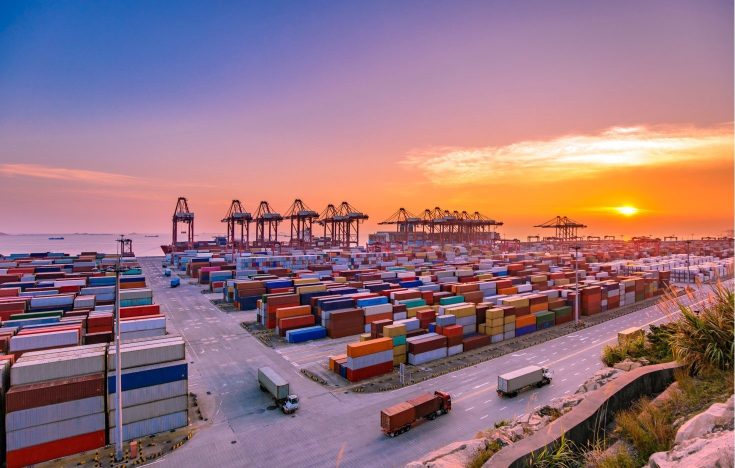Scores of vessels continue to lie at anchor awaiting a berth in the waters outside the Ports of Los Angeles and Long Beach, the busiest commercial harbor complex in the United States. With every day the vessels wait to offload their cargo, the economics of their journeys worsen, saddling suppliers and manufacturers and consumers alike with unforeseen costs and lost opportunities.
The logjam off the California coast is just one of many recent unforeseen problems that have exposed the vulnerabilities of the global supply chain: From the grounding of the Ever Given in the Suez Canal in March 2021, which impacted approximately 12% of global trade, to truck driver shortages in the UK and extreme weather events in North America.
Given the ongoing struggle with COVID-19 disruptions coupled with the impacts of climate change, continued intermittent and even sustained supply chain chaos may become the new normal. In a recent poll conducted by Gartner[1], almost 7 out of 10 chief supply chain officers said that since 2019 their systems have been responding to “high-impact risk events” without adequate preparation. Highlighting the impact of these prolonged disruptions, McKinsey found that companies should expect to suffer losses equal to 45% of a year’s profits over the course of the next decade.
With this in mind, companies are now seeking to better position their businesses by examining supply chains against a broader set of objectives, said Suresh Subramanian, Head of Trade & Treasury Solutions Americas at BNP Paribas. The mission: create a strategy that minimizes disruption to the supply chain without dramatically increasing balance sheet inventory and encumbering significant working capital.
From Just in Time to Just in Case
Major distribution breakdowns are expected to impact industries about every 3.7 years, according to McKinsey. Moreover, the last two years have shown that multiple disruptions can occur at the same time, magnifying the impact. The same McKinsey study reveals how companies going forward will need to find the right balance between “just-in-time” and “just in case” supply chain structures by having sufficient backup inventory of key components as a buffer to minimize the impact of disrupted supplies.
This is a departure from the long-held mind-set that it was imperative to run lean and not encumber working capital in high inventory levels. A “just in time” supply chain design relied upon a finely tuned ecosystem of suppliers, transportation networks and software tools to ensure inventory supply and demand were well synchronized to deliver sales, profits and growth in a timely fashion at the lowest cost.
With the disruptions of the last two years persisting, today a new imperative has become part of the equation, “just-in-case.” No company wants to lose a quarter or two’s revenue due to unforeseen supply disruption; moreover, there is a real risk to customer retention, which can have a long-term impact. A recent Oracle survey of over 1,000 U.S consumers illustrates that impact, with 84% saying delays would cause them to cancel their order and 80% saying delays or shortages would even cause them to stop buying from a brand entirely.
“Proactive supply chain strategies that emphasize resilience and the agility to weather disruptions have taken on much greater importance for corporates over the past few years,” Subramanian said.

Proactive supply chain strategies that emphasize resilience and the agility to weather disruptions have taken on much greater importance for corporates over the past few years.
Suresh Subramanian, Head of Trade & Treasury Solutions Americas, BNP Paribas
While it’s unlikely the financial imperatives of lean inventory management will be rejected completely, companies must now find a means to balance between “just in time” and “just in case.”
Designing the “new” Supply Chain
To remain competitive, supply chain managers are evaluating or already employing at a wide range of options to achieve their objectives, noted Subramanian. Techniques include eliminating sole source suppliers and single country sourcing, near shoring and more modular product designs. Digitization and artificial intelligence are being integrated into new supply chain models, increasing increased visibility and deepening cross supply chain collaboration.
One approach that is gaining traction is having sufficient levels of immediately available “safety stock” as insurance – a last line of defense – against supply chain disruption. Yet maintaining ready inventory buffers poses the problem of capital allocation. The last thing companies want to do is add the costs of safety stock and increase inventory balances — that’s a big reason “just in time” was so widely adopted. So how do companies maintain additional inventory buffers without impacting their working capital and swelling their balance sheet?
Third-party service providers are offering new solutions that address this challenge. These providers are able to step into a supply chain in a non-disruptive fashion, purchase inventory from suppliers, hold inventory buffers on their balance sheet and selling the inventory essentially “just in time” to clients. While these solutions are not an immediate panacea for today’s immediate shortages, they will provide more agility by offering insurance against unplanned and uncontrolled supply chain disruptions, at a cost generally well below a company’s weighted average cost of capital.
Mastering the balance between working capital efficiency and supply chain resilience is a challenge that is top-of-mind for companies as a result of the pervasive disruptions of 2020 and 2021. There is no one “magic bullet”, digital tool or sourcing technique that can ensure that future disruptions will not occur. In fact, history would indicate that disruptions will continue to occur, and proactive companies who have addressed their supply chain vulnerabilities will be better positioned to minimize the impact caused by future disruptions.
“Companies that employ a combination of approaches and techniques to mitigate supply chain risk will deliver positive outcomes in the face of adversity for their business in the years ahead,” said Subramanian.
[1] Adopt a New Supply Chain Strategy to Minimize Risk Impacts, Gartner, July 6, 2021, p. 5
